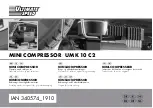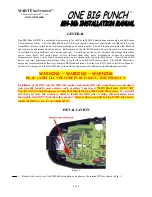
4
OPERATION
The compressor is driven by the vehicle's engine and
functions continuously while the engine is in operation.
Actual compression of air is controlled by the compressor
unloading mechanism operating in conjunction with a
governor.
AIR INTAKE (LOADED)
Just as the piston begins the down stroke, (a position
known as Top Dead Center, or TDC), the vacuum created
in the cylinder bore above the piston causes the inlet reed
valve to flex open. Atmospheric air flows through the open
inlet valve and fills the cylinder bore above the piston.
See
Figure 6.
AIR COMPRESSION (LOADED)
When the piston reaches the bottom of the stroke, (a
position known as Bottom Dead Center, or BDC), the inlet
reed valve closes. Air above the piston is trapped by the
closed inlet reed valve and is compressed as the piston
moves upwards. When air in the cylinder bore reaches
a pressure greater than that of the system pressure, the
discharge reed valves open and allow air to flow into the
discharge line and air brake system.
At the same time, air flows into the hollow center of the
unloader piston through an opening in the end of the piston.
Compressed air acts on the interior surfaces of the unloader
piston and — along with the unloader piston spring — holds
the unloader piston in the down position, against its seat
on the valve plate.
See Figure 7.
FIGURE 7 -
OPERATION - LOADED (COMPRESSION)
Piston Moving Up
Air Inlet
Port
Inlet
Valve
Closed
Air
Discharge
Port
Discharge
Valve
Open
Unloader
Piston
Down &
Seated
Valve
Plate
Unloader
Port
Cooling
Plate
FIGURE 6 -
OPERATION - LOADED (INTAKE)
Piston Moving Down
Air Inlet
Port
Inlet
Valve
Open
Air
Discharge
Port
Discharge
Valve
Closed
Unloader
Piston
Down &
Seated
Valve
Plate
Unloader
Port
Cooling
Plate





































